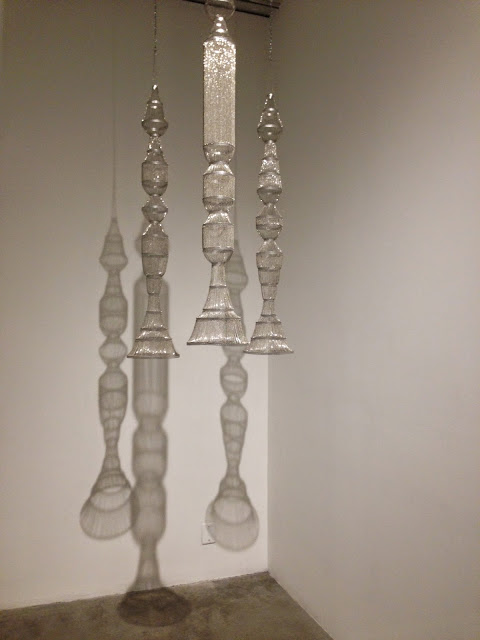To naysayers of contemporary art, Pierre Huyghe’s
retrospective at LACMA is bound to be the last straw. To an open mind, it will have
a positively jostling impact. Huyghe’s body of work is as contemporary as it
gets: it is unpredictable, hyperkinetic, and not for the lazy. This exhibition requires
an amount of effort, be it in the form of resistance or surrender. It is hard
to be unaffected by what might as well be a self-governing organism: a
smattering of live ants follow a trail of rat pheromone; Human, the artist’s dog, perambulates the galleries; there are a
few giant aquariums, and then there is Untilled
(Liegender Frauenakt), the reclining nude with an active beehive for a
head. The artist is not the sole meaning-maker here.
 |
| Untilled (Liegender Frauenakt), concrete cast with beehive structure, wax. Photo courtesy Annenberg Media Center |
Pierre Huyghe (pronounced hweeg) was born in 1962
in Paris and since the 1990s has been playing with the concept of
“auto-generative” art. If you thought Alexander Calder’s kinetic sculptures —
shown in the same pavilion earlier this year — were animated, Huyghe’s
exhibition will stop you in your tracks.
The threshold into Huyghe’s world is disappointing, if not
anticlimactic—you are welcomed by nothing but blank walls angled in seemingly
slapdash ways. It is confounding, until the sense of disruption morphs into
liberation: Ah, I see, this exhibition is here for me to play. If the artist
can break boundaries so can I.
One protean space leads to another, or to a dimly lit room,
or to a manufactured world outside, dripping with precipitation (fog, snow,
rain). In some recesses there is so much light deprivation you get the urge for a dose of sun. Sounds echo around you, some so vivid you can’t tell if
they’re real-time or from one of the handful of films rolling.
 |
| Installation view. Photo courtesy Esther Schipper |
In Huyghe’s
twenty-five year career, film has been a mainstay. His 2014 film, Untitled (Human Mask), captures the
human penchant for manipulation: a monkey, wearing the mask of a woman, is
being trained to work as a waitress. Huyghe describes it as a dystopic portrait
of human alienation. It feels perfectly apropos for the disorienting, sometimes
sparse, sometimes lonely spaces in this exhibition.
 |
| Untitled (Human Mask), 19-minute film. Photo courtesy LACMA |
Even if Pierre Huyghe
feels a bit like the artist’s personal play space, it is splendidly self-aware.
The raw, unframed documents on the display feel like personal messages
from Huyghe. L’Ecrivain public is his chronicle of the exhibition's opening, voyeuristic and full of banal
observations that cannot resist amusement (celebrities and museum aristocracy, like Director Michael Govan, are mentioned). Reading it soothes the urge to be that fly on
the wall.
Look up and you'll notice the ceiling doubles as a light grid that visitors can operate. Before reaching for a joystick, you have to ask yourself, Am I allowed to touch this?
Look up and you'll notice the ceiling doubles as a light grid that visitors can operate. Before reaching for a joystick, you have to ask yourself, Am I allowed to touch this?
This is where Huyghe’s exhibit can get infuriating. You
don’t know where the lines end and begin. The synchrony couldn’t be more
perfect: Huyghe is pushing you to challenge your obedience in manufactured
spaces. You learn to anticipate moments of freedom, and, inversely, moments of
disappointment: those beds of piled fur, begging to be sat on? Those are not
for you but for Human, the artist’s
Ibizan hound.
 |
| Human, dog. Photo courtesy Autre |
Pierre Huyghe is on view at LACMA through February 22, 2015.


























,+1962-63,+Image+Courtesy+of+the+Estate+of+John+Altoon+and+The+Box,+Photo+by+Fredrik+Nilsen.jpg)
,+1962-63,+Image+Courtesy+of+the+Estate+of+John+Altoon+and+The+Box,+Photo+by+Fredrik+Nilsen.jpg)
.jpg)
+Claude+Boutet,+1708+.jpg)